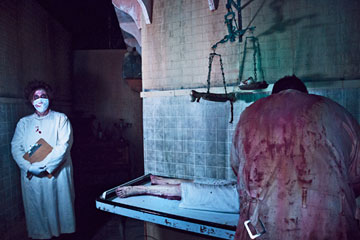
Not scared at the Headless Horseman in Ulster Park, N.Y.? You may already be undead.
A bloodred stain marks the dressmaker's dummy that guards the door to Michael Jubie's office. Beyond that silent sentry and up an old staircase, Jubie commands 250 two-way radios and a split-screen array of the security cameras that watch over Headless Horseman Hayrides & Haunted Houses in Ulster Park, N.Y., the autumnal attraction he co-owns. Its 45 acres are home to six haunted houses. Inside, Jack the Ripper's gutted victims share space with portraits that come alive as you pass and twitching baby dolls with eyes that seem to follow you. It is, in a word, scary.
But these days scary isn't so easy to define. Anecdotally, many independent haunts are going gangbusters, despite gloomy signs. (The National Retail Federation has found that Halloween spending is down, with about 12 million fewer Americans planning to celebrate this year than last, and Yahoo data show fewer searches for haunted houses.) Those in the industry say low numbers are likely an aberration and that business can be affected by any number of things, like weather or elections. The obstacle that does come up over and over in conversations with haunters is not about getting customers interested--it's about how people are getting harder to frighten.
"I firmly believe that the pop-out scare, the quick startle, still is the best scare," says Jubie. "But our guests are looking for Hollywood-quality sets and scares."
"As we evolve as an industry, it becomes more challenging to scare people," echoes Jim Schopf, an owner of Field of Screams, near Lancaster, Pa. "When we started this, we took our cornfield, mowed a path, bought masks and scared people by jumping out of the corn. That doesn't do it anymore."
A lot's at stake in haunted houses' getting scarier. Haunting has become what Ben Armstrong, who runs Netherworld, near Atlanta, calls "an entire miniature economy" of vendors and artisans. The industry even has a trade group, the Haunted Attraction Association (HAA). (A schism among scarers about things like officer term limits has led some haunters to reject the HAA. "We denounce them," says Amber Arnett-Bequeaith, who runs the Edge of Hell, in Kansas City, Mo., and is a member of America Haunts, a group that bills itself as representing "premier" haunts only.) In 2008, the haunters' trade show announced that it would spin off from the general Halloween retail show; its first year, it drew about 100 exhibitors and 1,500 buyers. Now, according to Jennifer Braverman, who owns TransWorld, the company that runs the show, those numbers are close to 800 and 8,000. There's no firm count of America's professional independent haunted houses, but there may be thousands, and just one can pull in that many customers per night.
Harder to Horrify
Haunters disagree about the cause of their customers' rising shock resistance and how to respond to it. Arnett-Bequeaith--her family has been in the business for nearly 40 years, and she took childhood naps in a prop coffin--is in the camp that says a culture of normalized violence, often shown in realistic CGI, may be to blame. "Kids today, it takes so much more to get them to that level, that fear reaction," says Arnett-Bequeaith. "They're so used to it, you know? They see [violence] in the movies, they see it if they're playing video games."
